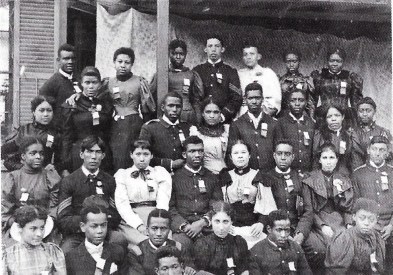
Due to a transition in staff, the University Archives is currently not taking any new requests.
Thank you for your patience and support.

The University Archives preserves a part of the rich heritage and tradition of the University. The collection is one of the nation’s largest and most comprehensive collection of materials on the history and culture of African Americans and Native Americans. Among the archive’s holdings are more than 8 million documentary items and over 50,000 photographs and glass negatives reflecting Hampton’s role in American education, educational philosophy, political activities, labor issues, and business and international relations. Within the collection are approximately 2 million items and 19,000 photographs relating to the American Indian Education Program.
Among these photographs are historic images taken on western reservations that exist nowhere else in the world.
Many of the photographs in the archives document the material culture collections in the Museum. This is especially true of the Native American materials, but it is also true of the African, University history, fine art, and Asian/Pacific collections. Additionally, Hampton University has the most complete student records of any historical black college or university in the United States, making it a very valuable source for researchers of black education. Specific types of documents in the archives include letters to and from the university by past presidents and faculty, minutes from faculty meetings, discipline books, and individual files on students who have attended Hampton. Many of the notes on individual students were begun prior to the student’s arrival at Hampton and continued after his/her departure.
At Hampton…we are trying to solve the problems of an education best suited to the needs of the poorer classes of the south, by sending out to them teachers.
— Samuel Chapman Armstrong
Hampton Normal and Agricultural Institute was founded in April 1868 by 27-year-old Union Army Brevet Brigadier General Samuel Chapman Armstrong. Beginning with two teachers, fifteen students and little money, Armstrong set out to build a school that would be second-to-none. Based upon a philosophy of “Education for Life,” Armstrong developed a program which sought to train “the head, the hand, and the heart” His vision for Hampton was grand — to attract the most promising students in the south and, through a strong educational program, create the people who would become teachers and leaders of their communities.

To achieve these goals, instruction in agricultural and mechanical skills was combined with a strong academic program. In this way students could earn money to finance their education, supplement their low teachers’ pay in later life, and learn and teach the dignity of labor. Hampton’s program was a success. From its beginning until the death of the founder, twenty-five years later, Hampton grew from a tiny impoverished southern school for newly freed people into an institution of national renowned and international influence. The school’s graduates pursued careers in teaching, trades, law, religion, politics, business and agriculture. Students carried with them Hampton’s emphasis on life-long service to community. Another measure of the Institute’s success was that more than two dozen schools across this nation and around the world were founded on Hampton’s model.

The University Archives houses information and photographs pertaining to the Emancipation Oak, which is one of the National Historic Landmarks on the campus. The Emancipation Oak, 98 feet in diameter, was the site of the first Southern reading of President Lincoln’s Emancipation Proclamation. The peaceful shade of the oak served as the first classroom for newly freed men and women — eager for an education. Mrs. Mary Peake, daughter of a free colored woman and a Frenchman, conducted the first lessons taught under the oak. The Emancipation Oak was designated as one of the 10 Great Trees of the World by the National Geographic Society.
The collection of Hampton University’s most illustrious alumnus, Booker T. Washington (Class of 1875), is located in the Archives. Booker T. Washington was the founder of Tuskegee Institute. With the success of Tuskegee, he became a famous leader of African Americans and was a great public speaker as he travelled all over America. He spoke about education and how African Americans and white Americans could get along. Booker T. Washington will always be remembered as a great American teacher and leader.


A unique chapter in American history unfolded at Hampton between 1878 and 1923. During this 45 year period, the school conducted an unprecedented biracial educational program. Hampton Normal and Agricultural Institute was founded in 1868, in post-Civil War America, in response to the demand by newly freed African Americans for educational opportunities. Ten years after its founding, Hampton opened its doors to Native American students who then composed a significant portion of the student body for nearly a half century. Over 1,300 Native American students from 65 tribes attended Hampton. Records regarding these students who attended Hampton number approximately 50,000 and are located in the Archives.
Visit the Hampton University Archives newest initiative, The Hampton University Archives Collections Research Portal. We hope that this portal will help historians, researchers, faculty members, and students explore more deeply the University’s heritage, and the traditions that have come down through the years.
The Hampton University Archives Collection Research Portal was funded with a grant from The Andrew W. Mellon Foundation in partnership with LYRASIS, Art Conservation Department at the University of Delaware, Image Permanence Institute, HBCU Library Alliance and Conservation Center for Art and Historic Artifacts.

Please forward complete forms to: vanessa.thaxton-ward@hamptonu.edu
Request for Photo Reproduction
These forms are presented in Adobe Acrobat PDF format and needs to be viewed with Adobe Acrobat Reader.
After clicking DONATE button:
Hampton University Museum
200 William R. Harvey Way
Hampton University
Hampton, VA 23668
757.727.5308
Fax 757.727.5170
Archives 757.727.5374
Monday–Friday: 8am–5pm
Saturday, Sunday, and all Major Holidays: Closed
ARCHIVES are closed on Saturday and Sunday
GIFT SHOP hours are 8:30am to 4:30pm
Enter campus via the main gate at the light off William R. Harvey Way